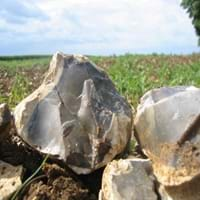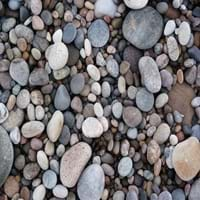Flint is a hard type of sedimentary rock that produces a small piece of burning material when hit by steel 0
From Old English flint - a type of rock mainly known for high hardness and for giving off sparks when struck 0
Durable Rock, Hard Rock 0
Fine Grained Rock, Opaque Rock 0
Black, Brown, Green, Grey, Red, White 0
Decorative Aggregates, Homes, Interior Decoration 0
As Building Stone, As Facing Stone, Garden Decoration, Office Buildings, Paving Stone 0
Arrowheads, Cutting Tool, Spear Points 0
Creating Artwork, Gemstone, In fire-starting tools, Manufacture of tools, Metallurgical Flux, Jewelry, To ignite fire, Used in flintlock firearms 0
Clasts are smooth to touch, Easily splits into thin plates, Has High structural resistance against erosion and climate 0
Archaeological Significance
0
Flint is formed by the decomposition and compaction of various organisms such as sponges and diatoms under the water. 0
Chemical Erosion, Coastal Erosion, Water Erosion 0
Heat Resistant, Impact Resistant, Pressure Resistant, Wear Resistant 0
Deposits in Eastern Continents
0
Azerbaijan, China, Russia 0
Austria, Belgium, Cyprus, Denmark, France, Germany, Italy, Malta, Netherlands, Poland, Portugal, Romania, Spain, Sweden, Switzerland, Turkey, Ukraine, United Kingdom 0
Deposits in Western Continents
0
Deposits in Oceania Continent
0
New Zealand, South Australia 0
Learn more about Properties of Flint
What is Flint? In this section, we will learn more about properties of Flint i.e. physical and thermal properties. Physical properties of Flint include Color, Streak, Hardness, Structure, Cleavage, Fracture, Luster, Specific Gravity etc. The strength of Flint is 450.00 N/mm2. Streak of Flint is white while its cleavage is non-existent. Luster of Flint is vitreous and its fracture is conchoidal. Flint is translucent to opaque in nature. Know all about Flint, What is Flint, its composition, features, facts and reserves in next sections.
Know about Composition of Flint
What is Flint composed of? Get to know about composition of Flint here. Flint definition gives information about the Formation of Flint and its composition.The composition of Flint can be further divided into mineral and compound content. The mineral content of Flint rock includes Silicon and The compound content of Flint rock includes Silicon Dioxide. Almost all rocks undergo transformation process. Know all about Flint rock in next section.









